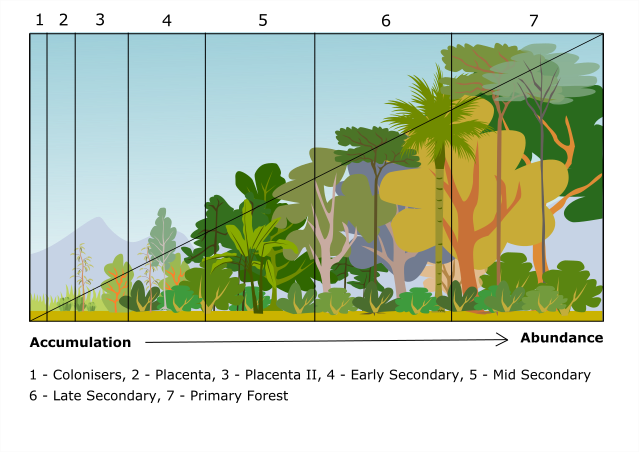Is Syntropic Agriculture Profitable? Part 2
This article is a follow up to my previous post about whether or not Syntropic Agriculture is profitable, you can find this here.
In the last article, I made the case that it comes down to who is doing it and how they make their strategy which will determine their success more than what actual method they use, such is the case with farming in general.
In this article I will cover some strategic considerations based on the structure of Syntropic Agriculture, which is based on species succession.
Species succession is the foundation of all true regenerative practices, an excellent example is Holistic Management - the management framework created by Alan Savory. Species Succession is the natural function of life on planet earth, this is an extremely strong power, largely unstoppable, and often fought against by humans when they try to impose their idea of “order”. Fighting against this always costs a lot of energy and resources and results in a lot of damage to the environment, it is also extremely intensive in its use of fossil fuel energy and poisons.
With the regenerative approach, we work WITH the power of species succession, and manage ecology to achieve our goals.
Above is a diagram of species succession outlined in Syntropic Nomenclature, translated from Portuguese. This is of course very similar to most visual expressions of species succession, but the specific stages detailed above relate to how we bring them into the Syntropic management framework for our designs.
STRATEGIC CONSIDERATIONS
First, let me begin by saying that Syntropic Agriculture works in just about any context, from Silvopasture to grains to tree crops, but a combination is best, because just one of the enterprises just mentioned, will cover a lot of the costs of the others - a lot of the work is done already. Utilising this requires a fully holistic approach - the whole is much more than the sum of the parts.
In reference to the above diagram, we see the 7 successional groups, this is where I recommend we base our strategy.
As long as the “consortium” is correct, and we manage it properly (this is not rocket science, but it is specific and precise, it takes a bit of learning - like anything worthwhile), each successional group will have incredibly strong growth. So essentially we are managing up to roughly seven cropping stages boosted through the power of species succession - facilitated through the Syntropic agriculture framework. We don’t always have to continually move upwards either, all we have to do is keep it moving up, but we can dwell in certain places, this will take too much too explain how here, so for the sake of simplicity, let’s say we are happy with the (relative) time frames above - which all relate to your climate and rainfall, plus how you manage.
What we set out to do, is plan how each successional group will provide on it’s way up the spiral of life and complexity, it's really that simple!
Your goals may end up with high succession tree crops, after providing you with a lot of yield on the way to that, or your high succession ecology may be what supports other crops, with a passive timber yield resulting in the tree rows, or browse fodder, all while that powerful ecology supports everything around it (increased soil carbon, extremely robust and complex soil ecology, covered soil etc).
I will illustrate this with examples:
Colinisers, this is the low down hardcore, seriously well adapted plants, if you need these you are starting from zero - Lichens and Mosses are part of this group, but towards the end of this phase, there are crops such as radish and other vigorous fast growing annuals.
Placenta, This successional group is named like this because it is considered to be the first real phase where the earth is covered, they way a placenta covers a baby. There are a very large number of crops that support humanity in this group, as this group is made up of a lot of annuals. Some examples are: Wheat, Rice, Vegetables, Corn, Beans and many more.
Placenta II, This successional group is where we have short lived perennials, “woody weeds” (such as Tamarillo). We can plan here a crop of Turmeric, Ginger, Globe Artichoke, Cassava, Asparagus, Taro etc. A lot of our Berry crops and similar species occupy this group and transition into early secondary and beyond. It is quite productive to begin a Berry enterprise here.
Early Secondary, This is where the trees really begin, Also there is a transition occurring from Placenta II. This phase is highly productive, as you can be still cropping placenta and placenta II crops in the alleys, while these plants boost the whole area (macro organism). Here we have a lot of really productive species such as Banana, Peach, Almond, Browse trees, Citrus and many more.
Mid Secondary, here is where the heavy hitters start to come into play, whereas beforehand they were being nursed by the plants in the earlier successional groups. These species may be Apple, Mango, Pear, Timber, and other longer lifecycle species. Because each successional group lives longer than the previous, you will have many years of production here, still supported by species succession. You will also be able to still browse your stock here, with a precise grazing plan, but I will make a blog post dedicated to that.
Late Secondary and Primary (Climax). You will be still carrying a lot of your mid secondary trees here if you choose to manage this way, as a lot of them are transitional. You can also run your stock here with the correct grazing plan, but this is the time when your high value timber crops will be paying their dividends. This is when you cash in, with a good financial plan coupled with your production plan, here is when you either retire, give it to your children, or expand by buying another farm. One very important thing is that your landscape will have transformed, it will be cooler in summer, warmer in winter, life will be expressing everywhere, water will not be a problem and I’ll bet everything that you will be happy!
There is more to this as far as how to go about Syntropic Agriculture, it is very fluid, and above is a simple example of what may be helpful in thinking strategically.
There is one very important thing that I must add before finishing - in each successional group there are a lot of plants - don’t exclude the very powerful service species which do the heavy lifting and provide biomass. Picking the right amount of cropping species in each successional group will yield well enough, the other service species will not dilute your density because the overall density of this type of Agroforestry often exceeds 250% of a standard monoculture - it is truly an agro-forest!
If you want to learn more about how to design a system based on your needs, we have a very affordable subscription community based learning platform which is growing weekly, there is a continually increasing amount of content. I have specifically set this platform up to be cheap and to facilitate online courses and group learning. If you would like to know more about it, please have a look here.
All the best to you and your regenerative future.
Scott.


